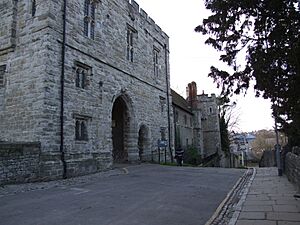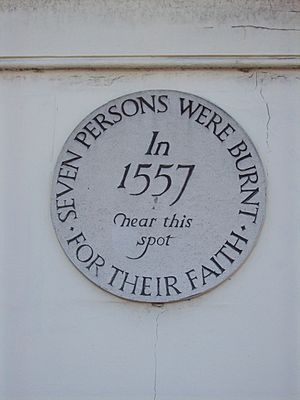History of Maidstone facts for kids
The history of Maidstone goes back a very long time, even before written records! People have lived here since the Mesolithic (Middle Stone Age) period. Later, the Romans and the Normans settled in the area. Maidstone also played a part in big moments in English history, like the Peasants' Revolt and the English Civil War. For many years, it was an important center for making beer and paper in Kent.
Contents
Early Times in Maidstone
We know people lived here in prehistoric times because of tools and other items found from the Mesolithic and Neolithic (New Stone Age) periods. Famous ancient sites like Kit's Coty and the Countless Stones are nearby.
The Romans made Maidstone more important. Their road from Watling Street at Rochester to Hastings passed through the town. This road connected Maidstone to the iron-making areas of the Weald. Roman villas and other sites have been found nearby. The Romans were also among the first to dig up stone, called Kentish ragstone, from the area.
Before the Normans arrived, Maidstone was a meeting place for a local area called a "hundred." A large open space north of town, now Penenden Heath, was used for important regional meetings and trials. One very important trial happened there right after the Normans took over England in 1066.
In 1146, a group of monks called Cistercians built an abbey (a monastery) at Boxley, northeast of Maidstone. This abbey was later destroyed in 1538 by Henry VIII during a time when many monasteries were closed down.
Around the same time, two hospitals were built in Maidstone to help travelers, especially those going on religious journeys. There was also a "college" for priests. In the early Middle Ages, a group called the Guild of Corpus Christi was based in the town. This guild helped its members when they were old or sick and arranged prayers for them after they died.
The Archbishop's Palace, by the River Medway, was given to the Archbishops of Canterbury in the 1200s. In 1381, the Archbishop at the time, Chancellor Sudbury, put a preacher named John Ball in prison here. But on June 11, 1381, a large group of peasants led by Wat Tyler freed John Ball. They were on their way from Canterbury to London to protest a new tax called the poll tax. This event was part of the famous Peasants' Revolt.
Maidstone in the 1500s and 1600s
Maidstone saw the death of Thomas Hitton in 1530. He is often seen as the first English person to die for his beliefs during the Protestant Reformation. Hitton followed a reformer named William Tyndale and had left England to avoid being arrested. When he returned in 1529 to share Tyndale's ideas and books, he was caught near Gravesend. After being questioned, he was sentenced to death and burned at the stake in Maidstone on February 23, 1530.
Maidstone officially became a town in 1549. Before this, it was run by a "portreeve" and a group of local leaders under the Archbishop of Canterbury. When it became a town, Maidstone was allowed to build a grammar school, which is still around today as Maidstone Grammar School.
In 1551, the people of Maidstone rebelled against the king in support of Thomas Wyatt. Because of this, the town's official status was taken away. However, a new charter was given five years later, making Maidstone a borough (a self-governing town).
On June 18, 1557, a miller named William Allin and his wife Katherine from Frittenden were burned at the stake in Fairmeadow, along with five other protestants. This happened during the Marian Persecutions, a time when Protestants were punished for their beliefs. The Allins were known for helping the poor and sharing religious writings.
Maidstone's town charter was confirmed again in 1619 by King James I, and a coat of arms was designed for the town.
The English Civil War
On June 1, 1648, during the Second English Civil War, a battle took place in Maidstone. About 2,000 Royalist soldiers were defending the town. They had built earthworks and other defenses. General Fairfax and his soldiers arrived in the afternoon, coming from Farleigh Bridge. The first fights started on the edge of town around 7 o'clock in the evening.
The Royalists fought bravely and managed to push back Fairfax's soldiers. More Royalist fighters from the town joined in, and there was fierce hand-to-hand combat. Fairfax was surprised that his well-trained soldiers were struggling. He had been watching from a distance, but he got on his horse and led his troops in a charge. After more heavy fighting, the Royalists were forced to retreat. Fairfax pushed forward, and the attack on the town began at 9 o'clock. By midnight, the remaining Royalists had been pushed into the churchyard, and they finally gave up.
Between 30 and 80 of Fairfax's men were killed. The Royalists lost about 300 soldiers, and 1,300 were captured.
Maidstone in the 1700s and 1800s
A new town hall was built in 1762–63. This building also served as the town's prison until around 1827.
In 1799, King George III and Prime Minister William Pitt visited Mote Park in Maidstone. They came to inspect about 3,000 local soldiers called the Kent Volunteers. These soldiers were training to defend the county from a possible invasion by Napoleon I of France. A special temple was built in the park to remember this visit.
Maidstone Prison is located north of the town center. It was designed by Daniel Asher Alexander and finished in 1819. It replaced older prisons in the town. The building work was even done by French prisoners-of-war.
The first of Maidstone's two army barracks was built in 1797 because of the threat from Napoleon. This barracks became the home of the West Kent Regiment. By 1813, the barracks were used to train young cavalry horses, and 20 years later, they became the Army Riding School. It was also a stopping point for soldiers going to colonies. In the 1860s, 600 men could be stationed there.
Kent County Council, which manages local government for Kent, has met in Maidstone since 1889.
In 1897, Maidstone had a serious outbreak of typhoid fever. There were 1,888 reported cases and at least 130 people died.
Maidstone During the World Wars
Detling, just north of Maidstone, was a Naval Air station during World War I and later served the Royal Air Force during World War II. Around 1939, other airfields were built near the town, including RAF West Malling and RAF Lashenden.
Maidstone was damaged by German Luftwaffe bombers during World War II. These planes sometimes dropped their bombs on Maidstone if they couldn't reach their main targets. V-1 flying bombs and V-2 rockets also fell in the area. On June 13, 1944, the first night of flying bomb attacks on London, Maidstone was hit by eight shells. This shelling from the French coast was the furthest German guns ever reached. The shelling stopped at 4 AM, and the first flying bomb landed minutes later. In total, 75 civilians in Maidstone Borough died from enemy attacks during the war.
The main office for No 1 Group Royal Observer Corps, a group that watched for enemy aircraft, was located in Maidstone until it closed in 1995.
Maidstone's Economy Through History
Maidstone's early economy was based on its role as a central market town for the farms in the Kent countryside. Its location on the River Medway (which had many smaller rivers flowing into it) made it easy to transport goods in and out of town for trade. The River Len and Loose Stream provided water power for many mills. These mills were used for different things, like cleaning wool, grinding corn, and making paper.
Having a lot of trade attracted skilled workers like craftsmen, which helped the local manufacturing economy grow.
Digging for building stone around Maidstone has always been important and still happens today. Some of the sandstone is also used in the glass industry. Nearby chalk pits in Burham have been used since Roman times. In the 1600s, the Wealden cloth industry (making cloth from wool) reached Maidstone. This was because there were deposits of Fuller's earth (used for cleaning wool) and, more importantly, the river for transporting the finished products.
At the end of the 1800s, Maidstone had many small breweries (places that make beer). The river was useful for transporting ingredients and for providing water for beer production. One of the biggest, the Style & Winch brewery, was on the river bank in the town center. It closed in 1965 and the building was torn down in 1976. There were five other breweries, but today only a small one called Goachers remains. Parts of the old Fremlins brewery are now part of the Fremlin Walk shopping arcade.
Paper mills, sometimes called "the treacle mines" by locals, also grew near the river. Paper was made at places like Turkey Mill and Hayle Mill. Important paper-making families and companies included the Whatman family and W&R Balston, starting in the 1700s. What later became the Reed group had several paper and cardboard mills in Maidstone.
See also
- Grade I listed buildings in Maidstone
- List of scheduled monuments in Maidstone



